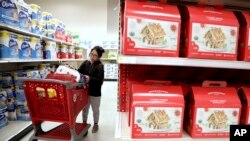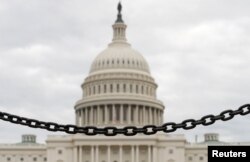The U.S. economy fell short of the Trump administration's 3 percent annual growth target in 2018 despite $1.5 trillion in tax cuts and a government spending blitz, and economists say growth will only slow from here.
A better-than-expected performance in the fourth quarter pushed gross domestic product up 2.9 percent for the year, just shy of the goal, Commerce Department data showed Thursday.
President Donald Trump has touted the economy as one of the biggest achievements of his term and declared last July that his administration had "accomplished an economic turnaround of historic proportions." On the campaign trail, Trump boasted that he could boost annual economic growth to 4 percent, a goal that analysts always said was unachievable.
"We are moving back to a sustainable growth pace that we experienced during most of the Obama years," said Joel Naroff, chief economist at Naroff Economic Advisors in Holland, Pennsylvania. "With the tax cut impacts largely done with, it is hard to see how growth can accelerate sharply."
Gross domestic product increased at a 2.6 percent annualized rate in the fourth quarter after advancing at a 3.4 percent pace in the July-September period. Economists polled by Reuters had forecast GDP rising at a 2.3 percent rate in the fourth quarter.
Growth in 2018 was the strongest since 2015 and better than the 2.2 percent logged in 2017. The expansion will be the longest on record in July.
The stronger-than-expected fourth-quarter performance, which reflected solid consumer and business spending, was despite many headwinds, including financial market volatility and the United States' trade war with China, raising optimism that an anticipated slowdown this year would not be abrupt.
The fiscal stimulus is believed to have peaked sometime in the fourth quarter. December economic data such as retail sales, exports, homebuilding and business spending on equipment weakened sharply.
In addition, most manufacturing measures softened in January and February, and motor vehicle demand has eased.
The labor market is also exhibiting signs of cooling, with a report from the Labor Department on Thursday showing the number of Americans receiving unemployment benefits rising to a 10-month high in the week ended Feb. 16.
"The first quarter won't be this good," said Paul Ashworth, chief economist at Capital Economics in Toronto. "As the stimulus fades and the lagged impact of past monetary tightening continues to feed through, we expect GDP growth to slow to 2.2 percent this year."
Slowing growth together with weakening global demand and uncertainty over Britain's departure from the European Union, support the Federal Reserve's "patient" stance toward raising interest rates further this year. Fed Chairman Jerome Powell reaffirmed the U.S. central bank's position in his testimonies before lawmakers Tuesday and Wednesday.
Inflation was largely muted in the fourth quarter.
The dollar trimmed losses against a basket of currencies on the GDP data and was last trading little changed. U.S. Treasury prices fell, while stocks on Wall Street were lower following weak earnings from a handful of companies.
Solid consumer spending
The fourth-quarter GDP report was delayed by a 35-day partial shutdown of the government that ended on Jan. 25, which affected the collection and processing of economic data. The Commerce Department said it could not quantify the full effects of the shutdown on fourth-quarter GDP growth.
Economists expect the longest shutdown in history will hurt growth in the first quarter. Growth in consumer spending, which accounts for more than two-thirds of U.S. economic activity, increased at a still strong 2.8 percent rate in the fourth quarter. Consumer spending grew at a robust 3.5 percent rate in the third quarter.
Consumption continues to be underpinned by a strong labor market, with inflation-adjusted income at the disposal of households jumping at a 4.2 percent rate in the fourth quarter compared to a 2.6 percent pace in the prior period.
A moderation in spending is, however, likely amid reports 2018 tax refunds have been smaller than in the previous years.
Business spending on equipment accelerated in the fourth quarter from the prior period, growing at a 6.7 percent rate, after losing speed since the first quarter of 2018.
Inventory accumulation
The trade deficit widened further as a combination of the U.S.-China trade dispute, strong dollar and weakening global demand restrained export growth. The trade tensions also led businesses to hoard imports.
The trade shortfall subtracted 0.22 percentage point from fourth-quarter GDP growth after slicing off 2 percentage points in the July-September period. With consumer spending slowing, some of the imports ended up in warehouses, accelerating the pace of inventory accumulation.
While that offset some of the drag on GDP growth from the trade deficit, the piling up of stock is bad news for first-quarter growth.
Inventories increased at a $97.1 billion rate in the fourth quarter after rising at an $89.8 billion pace in the July-September quarter. Inventory investment added 0.13 percentage point to GDP growth last quarter after contributing 2.33 percentage points in the prior period.
"There was a rapid buildup of inventories in the fourth quarter, so inventories likely will be a headwind for growth in the future," said Daniel Silver, an economist at JPMorgan in New York.
Residential construction contracted at a 3.5 percent rate, marking the fourth straight quarterly decline. Homebuilding has been weighed down by higher mortgage rates, land and labor shortages as well as tariffs on imported lumber.
Government investment increased at a 0.4 percent rate, the slowest since the third quarter of 2017. Nondefense investment contracted at a 5.6 percent rate, the biggest decline in five years, likely reflecting the effects of the five-week government shutdown.







